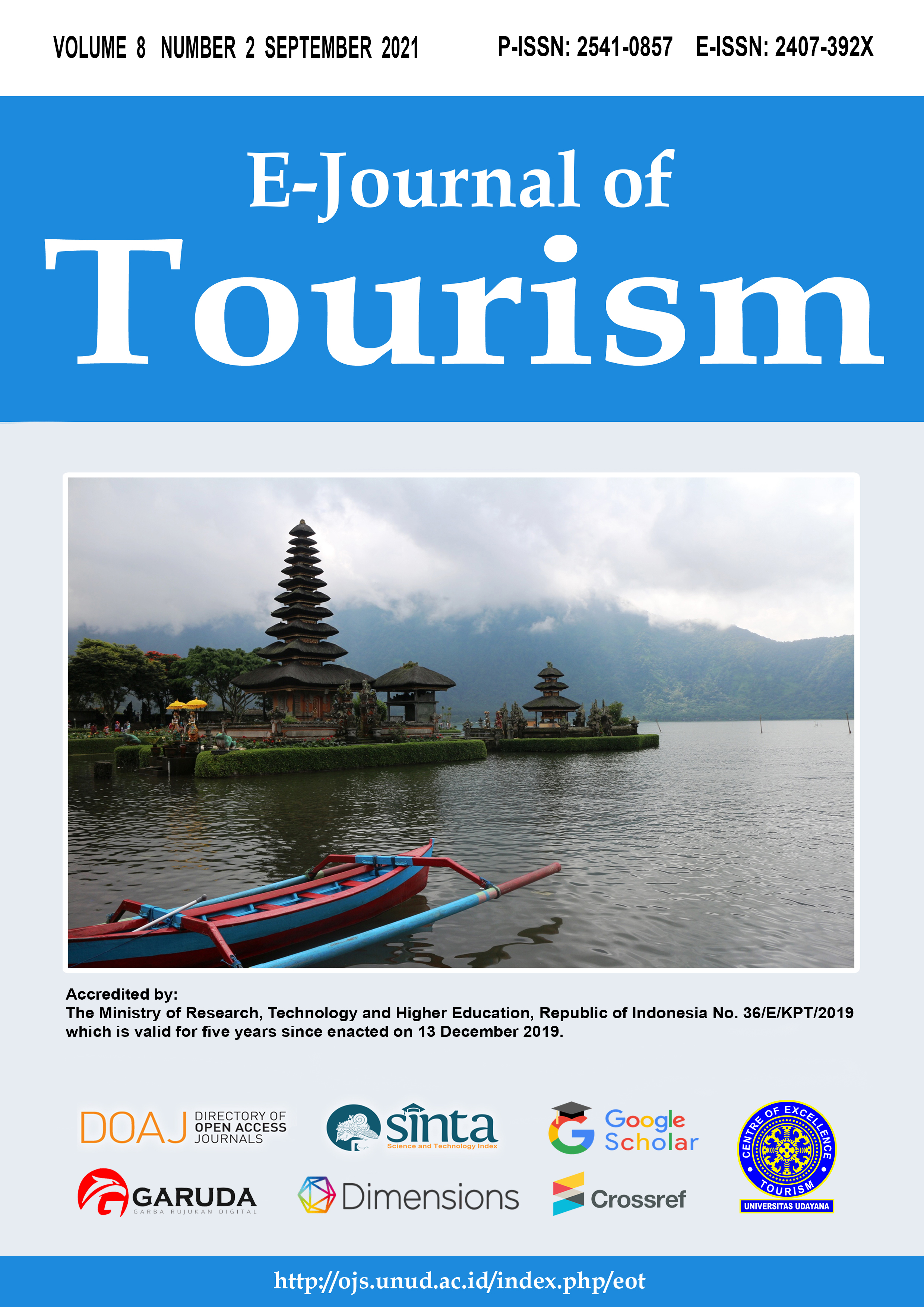Bali Imagined in the Context of Tourism
Abstract
The contention that Bali has been imagined in the context of tourism and that these images do not necessarily correspond to the realities of the destination is not entirely new. However, what this paper argues is that imaginings have occurred over time and began well before the advent of tourism, before becoming incorporated into a more fully developed and more globally recognised tourism image with many elements of the ‘tourist gaze’. These gazes are not just externally derived, but also owe a lot to local imaginings of what Bali might be, namely the notion that Bali is some kind of heir to the renowned Hindu-Javanese kingdom of Majapahit based in Java. This paper traces the evolution of these images blending earlier reports of seafarers, colonial administrators both Dutch and British, as well as artists who have lived on the island, into the world of the contemporary media-scape.
Downloads
References
Boon, J. A. (1977) The Anthropological Romance of Bali 1597-1972. Dynamic Perspectives in Marriage, and Caste, Politics and Religion. Cambridge University Press.
Cohen, M. (2016) Inventing the Performing Arts: Modernity and Tradition in Colonial Indonesia. Honolulu: University of Hawai’i Press.
Hiroaki, O. (1991) パリ症候群 [Pari shōkōgun] (in Japanese). Trajal Books.
Hitchcock, M. (1991) Indonesian Textiles. London: British Museum Press.
Hitchcock, M. and Norris, L. (1995) Bali - The Imaginary Museum; The Photographs of Walter Spies and Beryl de Zoete. Kuala Lumpur: Oxford University Press.
Hobart, M. (2007) ‘Rethinking balinese dance’, Indonesia and the Malay World, 35(101), pp. 107–128.
Hobsbawm, E. (1983) Introduction: Inventing Traditions. In Hobsbawm, E. & Ranger, T. (eds.) The Invention of Tradition. Cambridge: Cambridge University Press.
Krause, G. (1988) Bali, 1912: Photographs and Reports by Gregor Krause. Wellington, N.Z.: January Books.
Lanfant, M. F. (1995) ‘International Tourism, Internationalization and the Challenge to Identity. In Lanfant, M.F., Allcock, J.B. & Bruner, E.M. (eds.) International Tourism: Identity and Change.’, in. London: Sage.
Miksic, J. N., Goh, G. Y. and O’Connor, S. (2011) Rethinking Cultural Resource Management in Southeast Asia: Preservation, Development, and Neglect. Anthem Press.
Picard, M. (1993) Cultural Tourism in Bali: National Integration and Regional Differentiation. In Hitchcock M., King, V.T. & Parnwell, M.J.G. (eds.) Tourism in South-East Asia. London: Routledge.
Picard, M. (1996) Bali: Cultural Tourism and Touristic Culture. Singapore: Archipelago Press.
Purchas, S. (1624) Hakluytus Posthumus or, Purchas his Pilgrimes. Cambridge: Cambridge University Press.
Raffles, T. S. (1817) The History of Java. London: Parbury and Allen, and John Murray.
Renfrew, C. and Cherry, J. . (1986) Peer Polity Interaction and Socio-Political Change. Cambridge: Cambridge University Press.
Selwyn, T. (1996) The Tourist Image: Myths and Myth Making in Tourism. New York: Wiley.
Shils, E. (1981) Tradition. Chicago: University of Chicago Press.
Urry, J. (1990) The Tourist Gaze. London: Sage.
Vickers, A. (1989) Bali: A Paradise Created. Singapore and Berkeley: Periplus.
Yamashita, S. (2003) Bali and Beyond: Explorations in the Anthropology of Tourism. Oxford: Berghahn.
de Zoete, B. and Spies, W. (1938) Dance and Drama in Bali. London: Faber and Faber.

This work is licensed under a Creative Commons Attribution 4.0 International License.
The copyright of the received article shall be assigned to the journal as the publisher of the journal. The intended copyright includes the right to publish the article in various forms (including reprints). The journal maintains the publishing rights to the published articles.




















